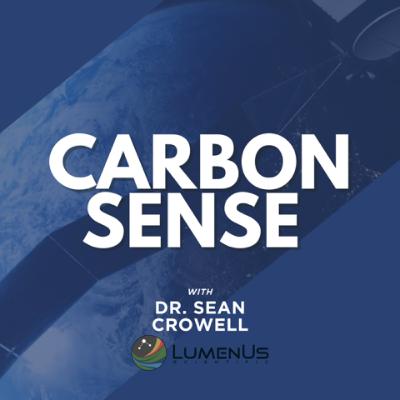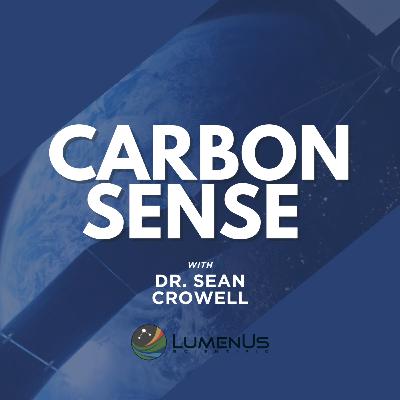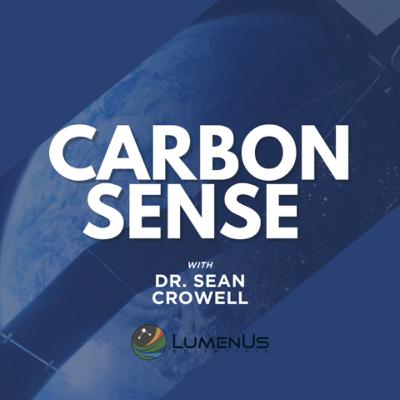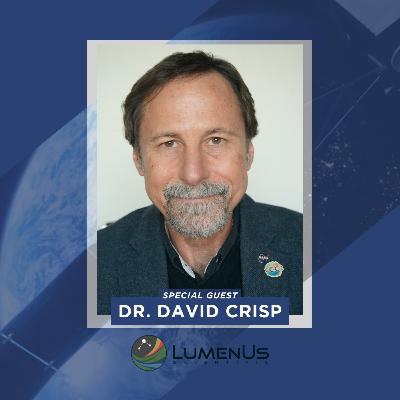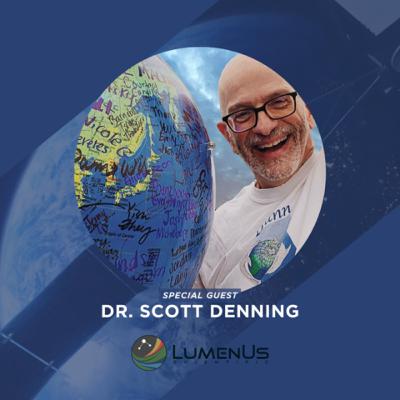Discover Carbon Sense
Carbon Sense

Carbon Sense
Author: LumenUs Scientific
Subscribed: 1Played: 9Subscribe
Share
© LumenUs Scientific
Description
Hosted by Dr. Sean Crowell, Founder and CEO of LumenUs Scientific, Carbon Sense explores the cutting-edge science and technology driving climate solutions. With a focus on the transformative power of satellite data, each episode dives into the pressing challenges of carbon emissions and climate change. Dr. Crowell brings his expertise and vision for an inclusive, mindful approach to advancing climate technologies, creating a platform for leading experts to share actionable insights and solutions. Tune in to discover how innovation and collaboration are shaping a better future for all of us.
18 Episodes
Reverse
In this conversation, Sean Crowell and Pete Roos discuss the innovative technologies developed by Bridger Photonics for measuring greenhouse gas emissions, particularly methane. They explore the power of LiDAR technology, the importance of accurate measurements, and the company's mission to simplify emissions reduction for the oil and gas industry. The discussion also touches on the significance of statistical analysis in emissions data, the evolution of emission factors, and the future of measurement technologies, including new developments and collaborations with regulatory bodies.KeywordsBridger Photonics, laser technology, emission reduction, LiDAR, greenhouse gases, environmental sensing, methane emissions, measurement accuracy, regulatory compliance, innovation
In this conversation, Tia Scarpelli discusses her journey in climate research, focusing on methane emissions from landfills and the complexities of solid waste management. She highlights the importance of understanding methane generation, the role of remote sensing in emission detection, and the challenges of measuring emissions accurately. The discussion also covers mitigation strategies for landfills and the need for effective stakeholder engagement to drive action towards reducing methane emissions.Keywordsclimate change, methane emissions, landfills, remote sensing, environmental engineering, solid waste management, greenhouse gases, emission detection, waste reduction, sustainabilityChapters03:30 The Importance of Landfills and Methane Emissions12:09 Understanding Landfill Composition and Methane Generation20:15 Modeling Methane Emissions from Landfills25:30 Research and Measurement Challenges in Landfill Emissions26:57 Measuring Greenhouse Gas Emissions31:14 The Role of Remote Sensing in Emission Detection35:24 Confidence in Remote Measurements39:58 Mitigation Strategies for Landfills46:56 CarbonMapper's Goals and Stakeholder Engagement
In this conversation, Sean Crowell interviews Aitor Morinigo, CEO of Satlantis, about the company's innovative approach to remote sensing and methane detection. Aitor shares his background in mechanical engineering and his journey from working in large corporations to leading a startup focused on satellite technology. The discussion covers the evolution of Satlantis, its partnerships with companies like Encino Environmental Services, and the importance of understanding customer needs in the oil and gas industry. Aitor also highlights the challenges of methane detection and the innovative technologies being developed to address these issues, like polarization sensitivity and higher spatial resolution in their next generation of sensors.KeywordsSatlantis, remote sensing, methane detection, satellite technology, environmental monitoring, space industry, EOChapters00:00 Introduction to Aitor Morinigo and Sattlantis02:10 Aitor's Journey into Remote Sensing and Engineering04:41 Transition from Traditional to New Space07:01 The Importance of Business Acumen in Engineering08:29 Overview of Sattlantis and Its Mission10:13 Sattlantis' Shift to Data Solutions12:58 Partnership with Encino and Industry Insights15:21 Innovative Technology for Pipeline Monitoring17:57 Multispectral Imaging and Its Advantages20:10 Combining Technologies for Enhanced Detection22:36 Business Model and Customer Engagement25:09 Future Developments and Innovations at Sattlantis
In this episode, Sean leads us on a journey through the history of the Orbiting Carbon Observatory missions and the scientists whose work has utilized the data to find key insights about the natural and human-influenced carbon cycle. This episode is being released due to the status of these missions being "on the chopping block" in the proposed NASA budget for 2026 by the Trump administration. Keywordscarbon dioxide, climate change, Orbiting Carbon Observatory, NASA, greenhouse gases, carbon cycle, emissions measurement, Earth science, environmental monitoring, climate policy
How do you detect methane leaks from space? And once you do - what comes next?In this episode, Dr. Ilse Aben shares the story of TROPOMI, the Dutch-led satellite instrument that scans the Earth daily for greenhouse gases. We explore how column measurements are turned into emissions, the power of'tip-and-cue' collaboration with commercial satellites, and how UN-backed systems are turning satellite data into climate action on the ground.• SRON Netherlands Institute for Space Research: https://www.sron.nl/• TROPOMI: https://www.tropomi.eu/• IMEO MARS Program: https://www.unep.org/explore-topics/climate-action/what-we-do/imeo• GHGSat: https://www.ghgsat.com/• Global Methane Hub: https://www.globalmethanehub.org/Episode Outline01:00–04:00 | Scientific Background04:00–09:15 | From SCIAMACHY to TROPOMI09:15–16:00 | How Satellites Measure Methane16:00–20:00 | Methane Sources Explained20:00–25:00 | Diffuse vs. Point Sources25:00–30:00 | Super Emitters and the Tip-and-Cue Model30:00–35:00 | IMEO & Global Mitigation via Satellites35:00–39:00 | Waste Emissions and Monitoring in the Global South39:00–43:00 | What’s Next in Satellite Methane Monitoring43:00–End | Final ReflectionsKeywordsgreenhouse gases, carbon sense, international cooperation, physics, spectroscopy, TROPOMI, satellite measurements
SummaryThis conversation delves into the insights from the EO Summit, focusing on greenhouse gas monitoring and pipeline methane emissions. It highlights the advancements in Earth observation technology, the importance of data integration, and the challenges faced in monitoring emissions effectively. The discussion emphasizes the need for trust in data, the role of incentives in emissions reduction, and the collaborative efforts required to address these environmental challenges.Chapters00:00 Overview of the Earth Observation Summit01:36 Insights on Greenhouse Gas Monitoring05:52 Challenges in Pipeline Surveillance and Methane Emissions08:21 The Role of Incentives in Emission Reduction11:43 Exploring Carbon Footprint and Its ImpactKeywordsTerraWatch Space, EO data, greenhouse gas monitoring, methane emissions, pipeline surveillance, Earth observation, environmental science, data integration, climate change, emissions reduction
In this conversation, Dr. Heather Couture discusses her work with Climate TRACE, focusing on the use of AI and satellite data to estimate CO2 emissions from power plants. She explains the importance of granular data for individual power plants, the challenges of estimating emissions accurately, and the need for collaboration in improving emission monitoring techniques. The discussion covers various aspects of machine learning, satellite technology, and the complexities of emissions data.KeywordsClimate TRACE, AI, CO2 emissions, power plants, satellite data, machine learning, greenhouse gases, emissions monitoring, environmental science, energy production
In this conversation, Sean Crowell and Aaron Davitt of WattTime discuss the intersection of climate data, remote sensing, and emission tracking. Aaron introduces the Climate Trace Coalition, which was founded by Watt Time and former US Vice President Al Gore to create comprehensive greenhouse gas emission inventories. Unlike the previous discussions of GHG remote sensing, this discussion highlights the use of different sets of satellite imagery (visible, thermal, SAR, etc) to locate sources for monitoring emissions across various sectors, the importance of data accessibility, and the collaborative efforts needed to improve emission estimates and mitigation strategies.This is Part 1 of a series on Climate TRACE. Key Topics:04:24 Aaron Davitt's Journey in Climate Science06:50 Understanding Watt Time and Its Role08:54 Overview of Climate Trace Coalition11:17 Utilizing Satellite Data for Emission Estimates13:43 Sector-Specific Emission Monitoring15:40 Innovative Approaches in Emission Estimation18:24 Collaboration and Open Data in Climate Trace20:36 Future Directions for Climate TraceKeywords: climate data, remote sensing, greenhouse gas emissions, satellite technology, Wattime, Climate Trace, emission inventory, environmental technology, data accessibility, collaboration, RMI
In this conversation, Aravind Ravichandran of TerraWatch, an industry insider for Earth Observation (EO), discusses the economic and public aspects of the industry, including challenges and opportunities. He emphasizes the importance of understanding the role of both government and commercial sectors in EO, the investment trends in satellite technologies, and the need for better data platforms and applications. The discussion also touches on the future of carbon monitoring and emission data, highlighting the significance of standards and collaboration in the field. Finally, Aravind introduces the EO Summit, aimed at bridging the gap between end users and technology providers.EO Summit: http://www.eosummit.comTerraWatch Space: http://www.terrawatchspace.comKeywordsEarth Observation, Remote Sensing, Satellite Data, Environmental Impact, Commercial Sector, Government Role, Investment Trends, Carbon Monitoring, EO Summit, Data PlatformsChapters00:00 Aravind's Journey into Earth Observation & TerraWatch08:04 Understanding Earth Observation16:21 Public Good vs. Commercial Data20:31 Investment Trends in Earth Observation27:57 Understanding Platforms vs. Applications in Remote Sensing37:55 The Future of Carbon Monitoring and Business Models50:39 Introducing the EO Summit: A Collaborative Forum for Earth Observation55:51 Introduction to Carbon Sense Podcast55:52 Exploring Carbon Footprint and Its Impact
This conversation delves into the ambitious GeoCARB project, which aimed to revolutionize carbon monitoring from space. Sean Crowell discusses the project's inception, technical achievements, and the challenges faced, including budget constraints and competition from international efforts. Despite the cancellation of the mission, the validated instrument remains ready for potential future opportunities, highlighting the resilience and persistence of the scientific community in the face of adversity.More about GeoCarb:http://www.ou.edu/geocarbKeywordsGeoCARB, carbon monitoring, NASA, greenhouse gases, climate science, remote sensing, environmental data, carbon cycle, geostationary orbit
In this conversation, Dr. Sean Crowell interviews Yasjka Meijer about the advancements in remote sensing technology and its application in monitoring greenhouse gases. They discuss the importance of satellite data, the role of the European Space Agency (ESA) and the Copernicus program, and the challenges faced in accurately measuring CO2 and methane emissions. Yashka shares insights from his career, the significance of continuous data collection, and the need for collaboration between public and private sectors to address climate change effectively. The discussion emphasizes the urgency of climate action and the role individuals can play in mitigating emissions.Learn more about CO2M and Copernicus here:https://www.esa.int/Applications/Observing_the_Earth/Copernicus/Introducing_Copernicushttps://www.eoportal.org/satellite-missions/co2mKeywords: remote sensing, greenhouse gases, satellite technology, climate monitoring, Copernicus program, CO2M mission, ESA, air quality, methane measurements, validationTakeaways- The Copernicus program aims to provide continuous data for climate monitoring.- Satellite technology is crucial for understanding greenhouse gas emissions.- Operational satellites must ensure data continuity and accuracy.- Engagement with the private sector enhances data utilization for climate action.- The CO2M mission focuses on measuring anthropogenic CO2 emissions.- Validation of satellite data is essential for accurate climate assessments.- The global stock take is a critical component of the Paris Agreement.- Public perception of climate change needs to shift towards urgency.- Individual actions can significantly contribute to reducing emissions.Outline00:00 Introduction to Remote Sensing and Greenhouse Gases00:56 New Chapter02:56 Yasjka Meijer's Journey in Atmospheric Science05:47 The Evolution of Copernicus Programs08:03 The Role of ESA in Earth Observation10:35 Engagement with the Private Sector in Copernicus12:54 The Importance of Continuous Monitoring15:46 CO2M: A New Era in Greenhouse Gas Monitoring17:59 Challenges in Measuring CO2 and Methane20:16 The Design and Functionality of CO2M Satellites35:08 Building on Heritage: The Role of Mission Advisory Groups37:54 Innovations in Spectrometer Design for CO2 and Methane Measurement41:37 The Importance of NO2 in Emission Estimates44:45 Addressing Aerosol Challenges in Satellite Observations47:09 Data Products and Collaboration in Greenhouse Gas Monitoring50:32 The Role of Copernicus in Climate Monitoring53:30 Validation and Accuracy in Satellite Measurements56:56 International Collaboration for Greenhouse Gas Monitoring59:30 The Role of SEOS in Climate Observations01:05:02 Personal Contributions to Climate Action01:08:37 The Urgency of Climate Change and Individual Responsibility01:17:55 Introduction to Carbon Sense Podcast01:17:56 Exploring Carbon Footprint and Its Impact
In this conversation, Sean Crowell interviews J-F Gauthier, Vice President of GHGSat, about the company's mission to monitor greenhouse gas emissions using satellite technology. J-F shares his unique journey into the field of remote sensing, the evolution of GHGSat, and the challenges faced by commercial entities in this space. The discussion covers the importance of accurate emission detection, collaboration within the remote sensing community, and the future goals of GHGSat, including the ambition to monitor every emitter globally on a daily basis. J-F emphasizes the need for actionable data to drive environmental change and the importance of collaboration among various stakeholders in the fight against climate change.Chapters00:00 Introduction to GHG-Sat and Its Mission00:20 JF Gauthier's Background and Career Path03:47 The Genesis of GHG-Sat and Its Technology06:38 Current Constellation and Future Plans08:30 Commercial Challenges in Methane Monitoring12:23 Understanding GHG-Sat's Detection Capabilities15:56 Validation Efforts and Transparency in Data21:54 Collaboration and Standardization in the Industry25:13 Uncertainty in Measurements and Its Implications25:50 Understanding False Positives in Methane Detection27:42 The Role of Wind in Emission Measurements29:52 Source Attribution Challenges in Emission Data32:46 Human Oversight in Automated Data Analysis34:14 Customer Interaction and Data Delivery39:53 Future Goals for GHGSat44:40 Challenges in CO2 Measurement49:36 The Importance of Actionable DataKeywordsGHGSat, remote sensing, greenhouse gases, methane detection, CO2 monitoring, satellite technology, environmental impact, emissions measurement, climate change, industrial emissionsWhite paper on GHGSat Validation: https://www.ghgsat.com/en/scientific-publications/validation-and-metrics-for-emissions-detection-by-satellite/
In this conversation, Sean Crowell and Dan Cusworth discuss the development and impact of CarbonMapper, a technology aimed at mitigating methane emissions through advanced remote sensing techniques. They explore the technological innovations that enable CarbonMapper, the importance of data transparency, and the collaboration with industry to address emissions. The conversation also touches on regulatory challenges and the future direction of CarbonMapper's mission to provide accessible data for emission mitigation globally.======================Check out the CarbonMapper data portal to learn more and find methane sources: https://data.carbonmapper.orgStanford single blind methane emission study:https://doi.org/10.5194/amt-17-765-2024Measurements mentioned:AVIRIS: https://aviris.jpl.nasa.gov/EMIT: https://earth.jpl.nasa.gov/emit/EnMAP: https://www.enmap.org/Hyperion: https://earthobservatory.nasa.gov/features/EO1Tenth/page3.phpPRISMA: https://www.eoportal.org/satellite-missions/prisma-hyperspectral
In this episode, Dr. Sean Crowell goes it alone to help boil down the first few episodes and give a high level summary on the fundamentals of carbon emissions and how we measure them from space.
In this conversation, Dr. Sean Crowell and Dr. David Crisp delve into the intricate interactions of light with matter, focusing on the principles of absorption, transmission, and reflection of photons. They explore the challenges of measuring greenhouse gases, the importance of accuracy and precision in remote sensing instruments, and the role of satellites in monitoring emissions. The discussion also highlights the differences between CO2 and methane, their sources, and their atmospheric lifetimes, while emphasizing the need for improved measurement systems to inform climate policy effectively.Chapters00:00 Understanding Light Interaction: Absorption, Transmission, and Reflection08:18 Modeling Planetary Atmospheres and Greenhouse Effects14:12 Measuring Accuracy and Standards in Spectrometry22:27 Signal to Noise Ratio: Precision in Measurements26:31 Remote Sensing Retrieval Algorithms and CO2 Measurement34:06 Applications of Greenhouse Gas Measurements41:41 Measuring Emissions: The Challenge of Cities45:03 The Evolution of Emission Mapping Instruments48:26 Commercial vs. Public Sector in Emission Monitoring52:39 The Need for Precision in Emission Measurements58:41 Understanding CO2 and Methane: Differences and Implications01:04:50 Challenges in Remote Sensing: Optical Path and Scattering01:19:25 The Future of Emission Monitoring: Lessons Learned and Next Steps01:21:38 Understanding Photons and Radiation01:21:47 The Importance of Subscribing and Supporting the Podcast
In this episode, Dr. David Crisp shares his remarkable journey from studying planetary atmospheres to leading the development of the Orbiting Carbon Observatory (OCO). He discusses the challenges faced during the mission, the importance of international collaboration in climate monitoring, and the advancements in remote sensing technology for measuring greenhouse gases. Dr. Crisp emphasizes the significance of accurate carbon dioxide measurements in understanding and combating climate change, and he reflects on the future of carbon monitoring and the role of scientific collaboration in addressing global environmental challenges.Keywords: remote sensing, greenhouse gases, carbon emissions, Orbiting Carbon Observatory, climate change, international collaboration, NASA, carbon dioxide measurement, space missions, environmental science
In this inaugural episode of Carbon Sense, host Sean Crowell welcomes atmospheric science expert Dr. Scott Denning, retired professor from Colorado State University and a pioneer in climate modeling. Together, they dive deep into the intricacies of carbon dioxide, methane, and the critical role they play in climate change. Dr. Denning explains the science behind the carbon cycle and how human activities have dramatically shifted the balance, with tangible effects on ecosystems and global warming.This conversation is packed with fascinating insights, from how plants “breathe” carbon dioxide, to why methane is the “Elvis” of greenhouse gases—it wiggles its hips but dies young. Whether you’re a climate science novice or a seasoned environmentalist, Dr. Denning’s engaging storytelling and practical breakdown of complex topics will leave you with a newfound appreciation for the world’s carbon dynamics.
Join us for Carbon Sense! This trailer gives an overview of what the podcast is all about.


